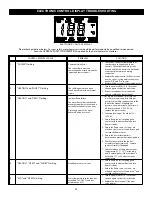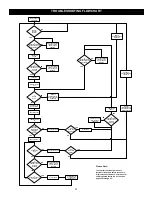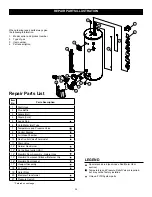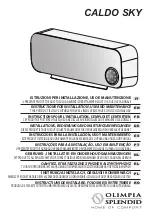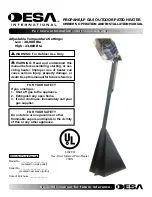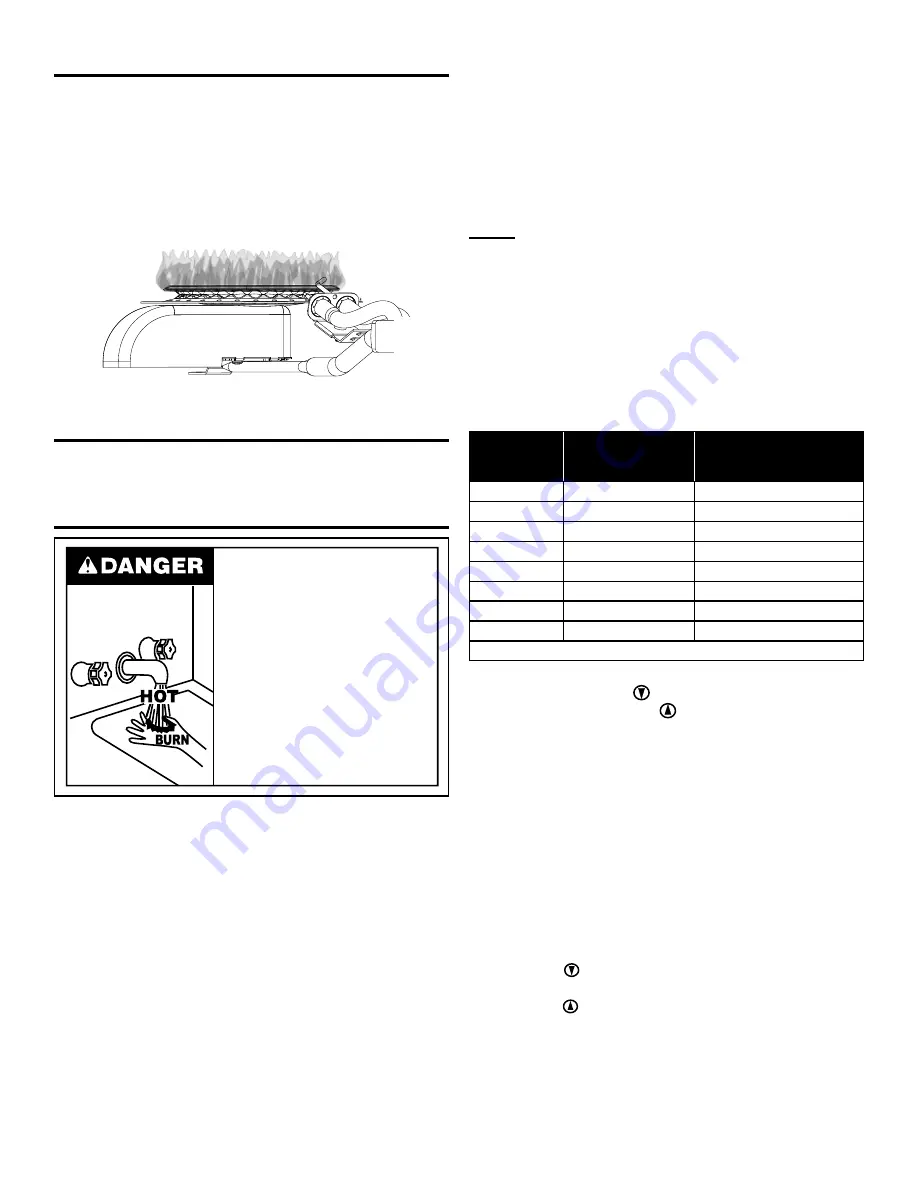
22
Burner Flames
Inspect the burner flames through the viewport and
compare them to the drawings in Figure 19. A properly
operating burner should produce a soft blue flame. Blue
tips with yellow inner cones are satisfactory. The tips
of the flame may have a slight yellow tint. The flame
should not be all yellow or have a sharp blue-orange
color. Contaminated air may cause an orange colored
flame. Contact a qualified technician if the flame is not
satisfactory.
FIGURE 19.
Emergency Shut Down
IMPORTANT: Should overheating occur or the gas supply
fails to shut off, turn off the heater’s manual gas control
valve and the electrical power. Call a qualified technician.
Water Temperature Regulation
Water temperature over 125°F (52°C)
can cause servere burns instantly
resulting in severe injury or death.
Children, the elderly, and the
physically or mentally disabled are at
highest risk for scald injury.
Feel water before bathing or
showering.
Temperature limiting valves are
available.
Read instruction manual for safe
temperature setting.
Due to the nature of the typical gas water heater, the water
temperature in certain situations may vary up to 30°F (16.7
°C) higher or lower at the point of use such as, bathtubs,
showers, sink, etc.
HOTTER WATER CAN SCALD: Water heaters are
intended to produce hot water. Water heated to a
temperature which will satisfy space heating, clothes
washing, dish washing, and other sanitizing needs can
scald and permanently injure you upon contact. Some
people are more likely to be permanently injured by hot
water than others. These include the elderly, children,
the infirm, or physically/mentally handicapped. If anyone
using hot water in your home fits into one of these groups
or if there is a local code or state law requiring a certain
temperature water at the hot water tap, then you must
take special precautions. In addition to using the lowest
possible temperature setting that satisfies your hot water
needs, a means such as a mixing valve, should be used
at the hot water taps used by these people or at the water
heater. Mixing valves are available at plumbing supply or
hardware stores, see Figure 14. Follow manufacturer’s
instructions for installation of the valves. Before changing
the factory setting on the thermostat see Figures 20 and
21. Using the lowest hot water temperature that meets
your needs will also provide the most energy efficient
operation of the water heater.
Never allow small children to use a hot water tap, or
to draw their own bath water. Never leave a child or
handicapped person unattended in a bathtub or shower.
NOTE: A water temperature range of 120°F-140°F
(49°C-60°C) is recommended by most dishwasher
manufacturers.
The thermostat of this water heater has been factory set
at its lowest position. It is adjustable and must be reset to
the desired temperature setting to reduce the risk of scald
injury. The electronic control display temperature should
be set at approximately 120°F (49°C) and this is the pre-
ferred starting point, see Figure 20. Some states have a
requirement for a lower setting. If you need hotter water,
follow directions for temperature adjustment, but beware of
the warnings in this section.
FIGURE 20.
Pressing the “COOLER” button decreases temperature
and pressing the “HOTTER” button increases the
temperature.
To avoid any unintentional changes in water temperature
settings, the control has a tamper resistant feature
for changing the temperature setting. To change the
temperature setting follow these instructions:
1. “Wake Up” the temperature indicators by holding down
both “COOLER” and “HOTTER” temperature adjust-
ment buttons at the same time for one second (See
Figure 19). The display will light up. The display will
only remain on for 30 seconds if no further buttons are
pressed. After 30 seconds the control will go back to
“Sleep” mode.
2. Release both of the temperature adjustment buttons.
A. To decrease the temperature press and release the
“
COOLER
” button until the desired setting is reached.
B. To increase the temperature press and release the
“
HOTTER
” button until the desired setting is reached.
NOTE: Should overheating occur or the gas supply fail
to shut off, turn off the manual gas control valve to the
appliance.
NOTE:
During low demand periods when hot water is not
being used, a lower thermostat setting will reduce energy
Water
Temperature
°F
Time for 1st
Degree Burn
(Less Severe Burns)
Time for Permanent Burns
2nd & 3rd Degree
(Most Severe Burns)
110
(normal shower temp.)
116
(pain threshold)
116
35 minutes
45 minutes
122
1 minute
5 minutes
131
5 seconds
25 seconds
140
2 seconds
5 seconds
149
1 second
2 seconds
154
instantaneous
1 second
(U.S. Government Memorandum, C.P.S.C., Peter L. Armstrong, Sept. 15,1978)























